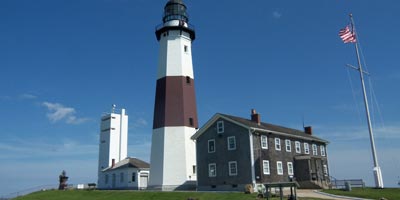
In the Mid-Atlantic region, heritage abounds and history seeps through the tapestry woven by centuries of inhabitants. For residents, that means playing parts in an ongoing story and living among a sea of historic places. For groups, it means a wide array of attractions are available for all ages and interest levels.
From lighthouses that have been beacons of hope for both seafaring communities and heartbroken seamen to a log house that was said to have played a vital role in sparking the Civil War, here are a few historic attractions perfect for heritage-hungry groups looking to learn about this quintessential American region.
Montauk Point Lighthouse
Montauk, Long Island, New York
When immigrants came to the United States in the early 1800s, their first glimpse of America was a hopeful beacon of light at the end of their long journey. The Montauk Point Lighthouse was built to provide safe passage for ships sailing to New York from England and France and has stood proudly at the easternmost tip of New York’s Long Island since 1796, acting as the 110-foot-6-inch welcoming symbol of the country to sailors and seafaring visitors.
Authorized by President George Washington in 1792, the Montauk Lighthouse was the first lighthouse in the state of New York and is one of only four active lighthouses in the entire United States. Today, groups can tour the historic lighthouse, the museum, the keeper’s dwelling and the storage building or just walk along the grounds of the national landmark.
“The museum is self-guiding and includes nine rooms of exhibits in the 1860 keeper’s dwelling,” explained Henry Osmers, historian of the Montauk Point Lighthouse with the Montauk Historical Society. “There are also monuments on the grounds, plus fantastic views of Block Island Sound and the Atlantic Ocean.”
It’s the 137-step spiral stairway, Osmers said, that catches most visitors unaware. But it never stopped him, as he’s been a fan of the lighthouse since his first sight of those steps in 1957 as a 7-year-old.
“Anyone who loves lighthouses, beautiful scenery and a fascinating history should come here,” Osmers added. “My greatest love is simply talking with visitors about the history of the lighthouse. It is a real passion of mine.”
www.montauklighthouse.com
Kennedy Farm
Hagerstown, Maryland
Known to many as John Brown’s Headquarters, the Kennedy Farm is spread across 194 acres and has played a huge role in this nation’s history during the Civil War era as the planning ground for John Brown’s infamous raid at Harpers Ferry across the Potomac River from the farm. After the site’s original owner, Dr. Robert F. Kennedy, passed on, Brown rented the cottage out for $35 and lived onsite in 1859 while planning his raid.
“John Brown was an abolitionist that many historians say caused the spark that began the Civil War,” said Thomas Riford, president and CEO of the Hagerstown-Washington County Convention and Visitors Bureau. “In many respects, John Brown was a terrorist; however, also, he was a hero. The Kennedy Farm is one of the most historic sites in the United States, and I enjoy touring the farmhouse, especially because there are several markers around the property which help explain the importance of the farm.”
The Kennedy Farm is a national historic landmark that was placed on the list for its role in this nation’s history. Today, the restored landmark is a great spot for groups to explore. The home is open for tours only by appointment;, groups can call the site’s keeper, South Lynn, to schedule a tour. Visitors can see historic documents spread throughout the home in which they were created, and they can get a sense for Brown’s life in the home as they walk into the dining room to see a realistic-looking John Brown mannequin fixing his gaze on entering tourists from his favorite spot around the dinner table.










